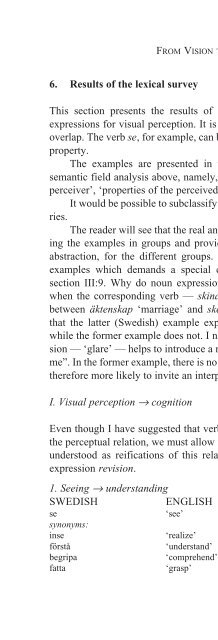Cognitive Semantics : Meaning and Cognition
Cognitive Semantics : Meaning and Cognition
Cognitive Semantics : Meaning and Cognition
You also want an ePaper? Increase the reach of your titles
YUMPU automatically turns print PDFs into web optimized ePapers that Google loves.
CONCEPTUAL ENGINEERING 155<br />
II. a list of parts ordered by their saliences. Salience is the ordering of parts<br />
<strong>and</strong> wholes according to their relative importance to the meaning of a<br />
term. Langacker does not have this ordering, although it is closely related<br />
to the centrality of domains.<br />
III. a list of wholes ordered by their saliences<br />
Take the lexical unit [KNIFE] as an example, as depicted in Figure 1. [BLADE]<br />
<strong>and</strong> [HANDLE] are clearly parts of [KNIFE].<br />
[KNIFE] has [SILVERWARE] as a whole: [KNIFE] is one of the parts in<br />
collections making up [SILVERWARE]. But [KNIFE] can also have [CUT] as a<br />
whole, because [KNIFE] can be the agent (TR) part of the cutting process.<br />
Parts <strong>and</strong> wholes like [BLADE] or [CUT] are themselves described with the<br />
same three elements. Their saliences, as well as the centralities, should be<br />
lexically stored but changed on activation to fit a context where that whole,<br />
part or domain is salient (this mechanism is not included in our immediate<br />
implementation goals).<br />
Of course, just saying that the [BLADE] is a part of [KNIFE] is not sufficient.<br />
We must characterize this part-whole relation closer. For instance, the relative<br />
sizes of the blade <strong>and</strong> the knife must not deviate outside certain limits. The<br />
relative spatial position of the blade on the knife must also be correct, i.e. the<br />
blade must be correctly attached. There are two possibilities of implementing<br />
these constraints, both involving the predication (below).<br />
Most of the content substance of a lexical unit resides in its domains,<br />
which collectively form its matrix. Typical domains are: color, 3D space,<br />
material, age, temperature, profession, emotion, etc. The matrix of a lexical<br />
unit (like [KNIFE]) allows the unit to involve all these aspects simultaneously<br />
<strong>and</strong> to be identified as the same entity across the domains (that this spatial<br />
form belongs to that color etc.).<br />
Domains are made up by dimensions. The color domain has three dimensions<br />
(hue, saturation <strong>and</strong> brightness), while temperature has one dimension.<br />
3D space has three dimensions. Profession <strong>and</strong> emotion domains probably<br />
have rather abstract dimensions.<br />
The lexical unit predicates in each domain in its matrix. In the spatial<br />
form domain, [KNIFE] predicates a 1D-directed form. In the color domain,<br />
[KNIFE] may predicate a brown color. A predication such as a 1D-directed<br />
form or a semancolor picks a subset of the total number of dimensions in the<br />
domain <strong>and</strong> attributes values to the dimensions in that subset. For example, a<br />
1D-directed form attributes a value to the spatial extension dimension. 2















